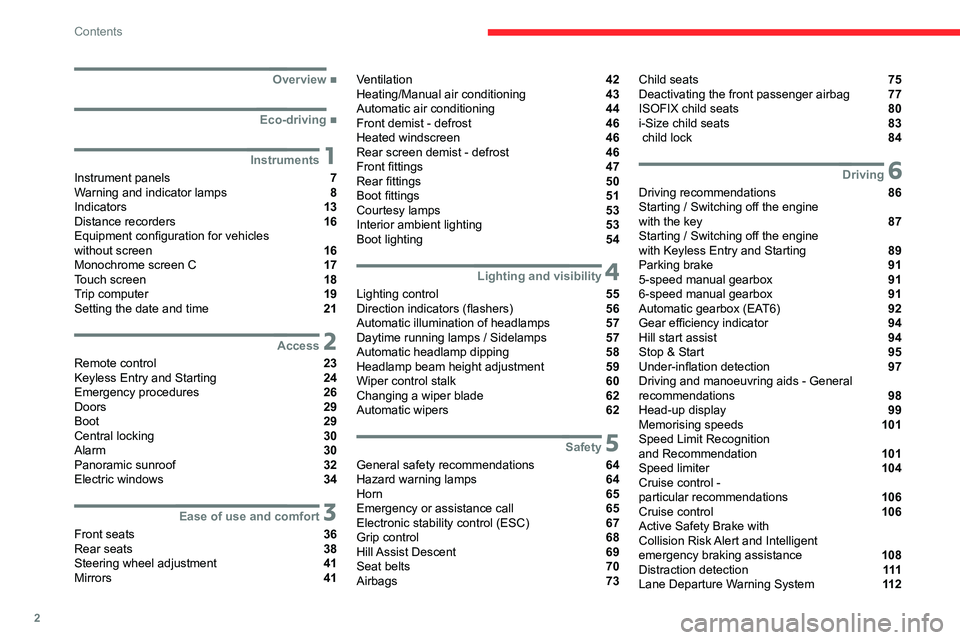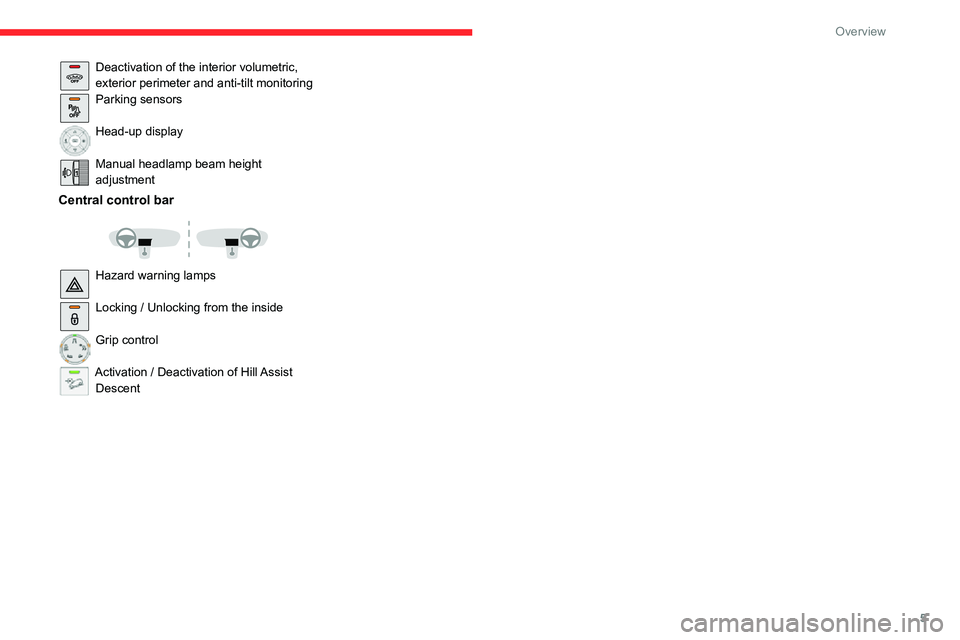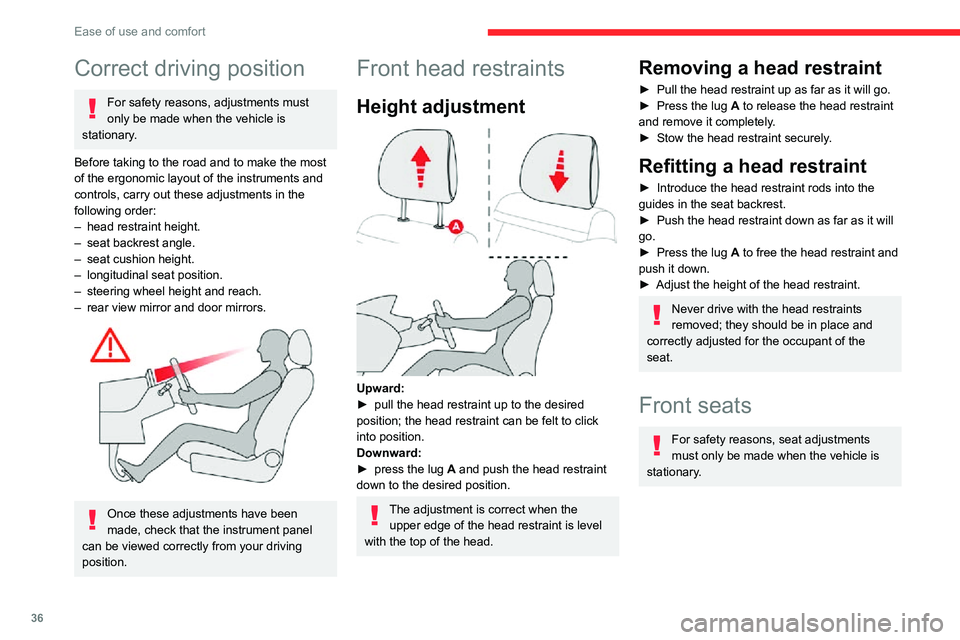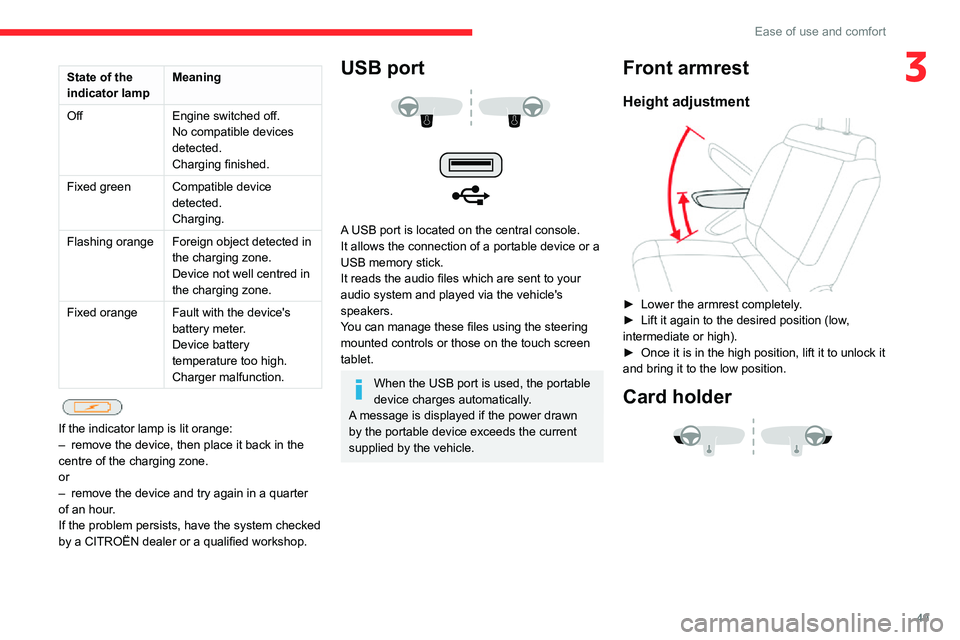height adjustment CITROEN C4 AIRCROSS DAG 2021 Handbook (in English)
[x] Cancel search | Manufacturer: CITROEN, Model Year: 2021, Model line: C4 AIRCROSS DAG, Model: CITROEN C4 AIRCROSS DAG 2021Pages: 244, PDF Size: 6.29 MB
Page 4 of 244

2
Contents
■
Overview
■
Eco-driving
1Instruments
Instrument panels 7
Warning and indicator lamps 8
Indicators 13
Distance recorders 16
Equipment configuration for vehicles
without screen
16
Monochrome screen C 17
Touch screen 18
Trip computer 19
Setting the date and time 21
2Access
Remote control 23
Keyless Entry and Starting 24
Emergency procedures 26
Doors 29
Boot 29
Central locking 30
Alarm 30
Panoramic sunroof 32
Electric windows 34
3Ease of use and comfort
Front seats 36
Rear seats 38
Steering wheel adjustment 41
Mirrors 41
Ventilation 42
Heating/Manual air conditioning 43
Automatic air conditioning 44
Front demist - defrost 46
Heated windscreen 46
Rear screen demist - defrost 46
Front fittings 47
Rear fittings 50
Boot fittings 51
Courtesy lamps 53
Interior ambient lighting 53
Boot lighting 54
4Lighting and visibility
Lighting control 55
Direction indicators (flashers) 56
Automatic illumination of headlamps 57
Daytime running lamps / Sidelamps 57
Automatic headlamp dipping 58
Headlamp beam height adjustment 59
Wiper control stalk 60
Changing a wiper blade 62
Automatic wipers 62
5Safety
General safety recommendations 64
Hazard warning lamps 64
Horn 65
Emergency or assistance call 65
Electronic stability control (ESC) 67
Grip control 68
Hill Assist Descent 69
Seat belts 70
Airbags 73
Child seats 75
Deactivating the front passenger airbag 77
ISOFIX child seats 80
i-Size child seats 83
child lock 84
6Driving
Driving recommendations 86
Starting / Switching off the engine
with the key
87
Starting / Switching off the engine
with Keyless Entry and Starting
89
Parking brake 91
5-speed manual gearbox 91
6-speed manual gearbox 91
Automatic gearbox (EAT6) 92
Gear efficiency indicator 94
Hill start assist 94
Stop & Start 95
Under-inflation detection 97
Driving and manoeuvring aids - General
recommendations
98
Head-up display 99
Memorising speeds 101
Speed Limit Recognition
and Recommendation
101
Speed limiter 104
Cruise control -
particular recommendations
106
Cruise control 106
Active Safety Brake with
Collision Risk Alert and Intelligent
emergency braking assistance
108
Distraction detection 111
Lane Departure Warning System 11 2
Page 7 of 244

5
Overview
Deactivation of the interior volumetric, exterior perimeter and anti-tilt monitoringParking sensors
Head-up display
Manual headlamp beam height adjustment
Central control bar
Hazard warning lamps
Locking / Unlocking from the inside
Grip control
Activation / Deactivation of Hill Assist
Descent
Page 38 of 244

36
Ease of use and comfort
Correct driving position
For safety reasons, adjustments must
only be made when the vehicle is
stationary.
Before taking to the road and to make the most
of the ergonomic layout of the instruments and
controls, carry out these adjustments in the
following order:
– head restraint height.– seat backrest angle.– seat cushion height.– longitudinal seat position.– steering wheel height and reach.– rear view mirror and door mirrors.
Once these adjustments have been
made, check that the instrument panel
can be viewed correctly from your driving
position.
Front head restraints
Height adjustment
Upward:► pull the head restraint up to the desired position; the head restraint can be felt to click
into position.
Downward:
► press the lug A and push the head restraint
down to the desired position.
The adjustment is correct when the upper edge of the head restraint is level
with the top of the head.
Removing a head restraint
► Pull the head restraint up as far as it will go.► Press the lug A to release the head restraint
and remove it completely.
► Stow the head restraint securely .
Refitting a head restraint
► Introduce the head restraint rods into the guides in the seat backrest.► Push the head restraint down as far as it will go.► Press the lug A to free the head restraint and
push it down.
► Adjust the height of the head restraint.
Never drive with the head restraints
removed; they should be in place and
correctly adjusted for the occupant of the
seat.
Front seats
For safety reasons, seat adjustments
must only be made when the vehicle is
stationary.
Adjustments
Forwards-backwards
► Raise the control bar and slide the seat forwards or backwards.► Release the bar to lock the seat in position on one of the notches.
Before moving the seat backwards,
ensure that there is no person or object
that might prevent the full travel of the seat.
There is a risk of trapping or pinching
passengers if present in the rear seats or of
jamming the seat if large objects are placed
on the floor behind the seat.
Height
(driver only)
Page 39 of 244

37
Ease of use and comfort
3AdjustmentsForwards-backwards
► Raise the control bar and slide the seat forwards or backwards.► Release the bar to lock the seat in position on one of the notches.
Before moving the seat backwards,
ensure that there is no person or object
that might prevent the full travel of the seat.
There is a risk of trapping or pinching
passengers if present in the rear seats or of
jamming the seat if large objects are placed
on the floor behind the seat.
Height
(driver only)
► Pull the control upwards to raise the seat or push it downwards to lower the seat, until the
position required is obtained.
Backrest angle
(driver)
► Turn the knob to adjust the backrest.
(passenger seat)
► Turn knob B or pull control B in the upwards
direction to adjust the backrest.
► When the backrest is correctly inclined, release the control.
To prevent the backrest from suddenly
folding forwards and hitting you, hold the
backrest with your back or hand while
adjusting.
Passenger seat backrest
table position
Check that no object, either on or
underneath the seat, could hinder its
movement.
► Place the head rests in the low position.► Pull control B at the back to the front and tilt
the backrest forward.
Page 42 of 244

40
Ease of use and comfort
► Lower the head restraints.► If necessary, move the front seats forward.► Pull the seats fully back (depending on version).► Check that no person or object will interfere with folding down the backrests (clothing,
luggage, etc.).
► Check that the outer seat belts are properly tensioned along the pillars, that the central belt
is stowed and that the tongues of the three belts
are correctly in the storage position.
Depending on version, the seat backrests are
equipped with a handle (bench seat with fixed
cushions) or a strap (bench seat on rails).
► Operate backrest release handle 1 or pull
strap 2.
► Guide backrest 3 down to the horizontal
position.
If the backrest is equipped with a strap, it
it not necessary to guide it down.
If the backrest is equipped with a handle,
its red indicator is visible when it is
released.
Returning the backrests to
their original position
First check that the outer seat belts are
lying vertically alongside the backrest
latching rings.
► Put backrest 3 in the upright position and
push firmly to latch it home.
► Check that release grip 1 has properly
returned to its position and that the red indicator
is no longer visible (depending on the version
you have).
► Ensure that the outer seat belts are not trapped during the manoeuvre.
When returning the rear seat backrest to
its original position, take care not to trap
the seat belts and ensure that their buckles
are positioned correctly.
The contents of the boot may be thrown
forward - Risk of serious injury!
Steering wheel
adjustment
► When stationary, pull the control lever
to release the steering wheel adjustment
mechanism.
► Adjust the height and reach to suit your driving position.► Push the control lever to lock the steering wheel adjustment mechanism.
As a safety measure, these adjustments
should only be carried out with the
vehicle stationary.
Page 43 of 244

41
Ease of use and comfort
3Steering wheel
adjustment
► When stationary, pull the control lever
to release the steering wheel adjustment
mechanism.
► Adjust the height and reach to suit your driving position.► Push the control lever to lock the steering wheel adjustment mechanism.
As a safety measure, these adjustments should only be carried out with the
vehicle stationary.
Mirrors
Door mirrors
Demisting - Defrosting
Demisting-defrosting of the door mirrors operates with the engine running, by
switching on the heated rear screen.
For more information on Demisting - defrosting
the rear screen , refer to the corresponding
section.
Adjustment
► Move control A or turn control C (depending
on the version you have) to the right or to the left
to select the corresponding mirror.
► Move control B or C (depending on the
version you have) in any of the four directions to
adjust.
► Return control A or C (depending on the
version you have) to its centre position.
As a safety measure, the mirrors should be adjusted to reduce the "blind spots".
The objects observed are, in reality, closer
than they appear.
Take this into account in order to correctly
judge the distance of vehicles approaching
from behind.
Manual folding
You can manually fold the mirrors (parking
obstruction, narrow garage, etc.)
Page 51 of 244

49
Ease of use and comfort
3State of the
indicator lampMeaning
Off Engine switched off.
No compatible devices
detected.
Charging finished.
Fixed green Compatible device
detected.
Charging.
Flashing orange Foreign object detected in
the charging zone.
Device not well centred in
the charging zone.
Fixed orange Fault with the device's
battery meter.
Device battery
temperature too high.
Charger malfunction.
If the indicator lamp is lit orange:
– remove the device, then place it back in the centre of the charging zone.
or
– remove the device and try again in a quarter of an hour.
If the problem persists, have the system checked
by a CITROËN dealer or a qualified workshop.
USB port
A USB port is located on the central console.
It allows the connection of a portable device or a
USB memory stick.
It reads the audio files which are sent to your
audio system and played via the vehicle's
speakers.
You can manage these files using the steering
mounted controls or those on the touch screen
tablet.
When the USB port is used, the portable
device charges automatically.
A message is displayed if the power drawn
by the portable device exceeds the current
supplied by the vehicle.
Front armrest
Height adjustment
► Lower the armrest completely .► Lift it again to the desired position (low , intermediate or high).► Once it is in the high position, lift it to unlock it and bring it to the low position.
Card holder
Page 61 of 244

59
Lighting and visibility
4• If the "AUTO" and "Main beam" indicator lamps were on, the system changes to dipped beam.
To reactivate the system, flash the headlamps
again.
The system may be disrupted or not work correctly:
– When visibility conditions are poor (snowfall, heavy rain, etc.).– If the windscreen in front of the camera is dirty, misted or obscured (for example, by a
sticker).
– If the vehicle is facing highly reflective signs.
When the system detects thick fog, it
temporarily deactivates the function.
The system is not able to detect:
– Road users that do not have their own lighting, such as pedestrians.– Vehicles whose lighting is obscured (for example, vehicles driving behind a safety
barrier on a motorway).
– Vehicles at the top or bottom of a steep slope, on winding roads, on crossroads.
Clean the windscreen regularly,
particularly the area in front of the
camera.
The internal surface of the windscreen can
also become misted around the camera.
In humid and cold weather, demist the
windscreen regularly.
Do not allow snow to accumulate on the
bonnet or roof of the vehicle as this could
obstruct the detection camera.
Headlamp beam height
adjustment
To avoid causing a nuisance to other road users,
the height of the headlamp beams should be
adjusted according to the load in the vehicle.
0. (Initial adjustment)
Driver only or driver + front passenger
1. Driver + front passenger + rear passengers +
maximum authorised load
2. Driver only + maximum authorised load
Cornering lighting
If your vehicle is so equipped, this system
makes use of the beam from a front foglamp to
illuminate the inside of a bend, when the main or
dipped beam headlamps are on and the vehicle
speed is below 25 mph (40 km/h) (urban driving,
winding road, intersections, parking manoeuvres,
etc.).
Without cornering lighting
Page 73 of 244

71
Safety
5due to the activation of the pyrotechnic
cartridge incorporated in the system.
In all cases, the airbag warning lamp comes
on.
Following an impact, have the seat belt
system checked, and if necessary replaced,
by a CITROËN dealer or a qualified
workshop.
Front seat belts
The front seat belts are fitted with a pyrotechnic
pretensioning system and a force limiting
system.
Height adjustment
► To adjust the height of the anchorage point, squeeze control A and slide it to the notch
desired.
Rear seat belts
Each of the rear seats has a three-point seat belt
with inertia reel.
The outer seats are fitted with a pyrotechnic
pretensioning and force limiting system.
Seat belts, centre rear
The seat belt for the rear central position is
integrated into the back of the roof.
Installation
► Pull the strap and insert tongue A into the left
buckle.
► Insert tongue B into the right buckle.► Check that each buckle is fastened correctly by pulling the strap.
Removal and storage
► Press the red button on buckle B, then the
button on buckle A.
► Guide the strap as it reels in and take tongue B, then A to the magnet at the anchoring point
on the roof.
Page 88 of 244

86
Driving
Driving recommendations
► Observe the driving regulations and remain vigilant whatever the traffic conditions.► Monitor your environment and keep your hands on the wheel to be able to react to
anything that may happen any time.
► Drive smoothly, anticipate the need for braking and maintain a longer safety distance,
especially in bad weather.
► Stop the vehicle to carry out operations that require close attention (such as adjustments).► During long trips, take a break every two hours.
Important!
Never leave the engine running in a
closed space without sufficient
ventilation. Internal combustion engines emit
toxic exhaust gases such as carbon
monoxide. Danger of poisoning and death!
In severe wintry conditions (temperature
below -23°C), let the engine run for 4
minutes before moving off, to ensure the
correct operation and durability of the
mechanical components of your vehicle
(engine and gearbox).
Never drive with the parking brake
applied . Risk of overheating and
damage to the braking system!
Do not park the vehicle or leave the
engine running on a flammable
surface (dry grass, dead leaves, etc.). The
exhaust system of your vehicle is very hot,
even several minutes after the engine stops.
Risk of fire!
Never leave a vehicle unattended with
the engine running. If you have to leave
your vehicle with the engine running, apply
the parking brake and put the gearbox into
neutral or position N or P (depending on the
type of gearbox).
Never leave children inside the vehicle
unsupervised.
On flooded roads
We strongly advise against driving on flooded
roads, as this could cause serious damage to
the engine or gearbox, as well as to the electrical
systems of your vehicle.
If you are obliged to drive on a flooded road:
► check that the depth of water does not exceed 15 cm, taking account of waves that might be generated by other users,► deactivate the Stop & Start function,► drive as slowly as possible without stalling. In all cases, do not exceed 6 mph (10 km/h),► do not stop and do not switch off the engine.On leaving the flooded road, as soon as safety
conditions allow, make several light brake
applications to dry the brake discs and pads.
If in doubt about the state of your vehicle,
contact a CITROËN dealer or a qualified
workshop.
In case of towing
Driving with a trailer places greater
demands on the towing vehicle and
requires extra care from the driver.
Respect the maximum towable weights.
At altitude: reduce the maximum load by
10% per 1,000 metres of altitude; the density
of the air decreases with altitude and the
performance of the engine reduces.
New vehicle: do not pull a trailer before
having driven at least 620 miles (1,000
kilometres).
If the outside temperature is high, let the
engine idle for 1 to 2 minutes after the
vehicle comes to a stop, to help it to cool.
Before setting off
Nose weight
► Distribute the load in the trailer so that the heaviest items are as close as possible to the
axle and the nose weight (at the point where it
joins your vehicle) approaches the maximum
permitted without exceeding it.
Tyres
► Check the tyre pressures of the towing vehicle and of the trailer, observing the
recommended pressures.
Lighting
► Check the electrical signalling on the trailer and the headlamp beam height of your vehicle.
If a genuine CITROËN towing device is
used, the rear parking sensors will be
deactivated automatically to avoid the audible
signal.
When driving
Cooling
Towing a trailer uphill causes the coolant
temperature to increase. The maximum towable
load depends on the gradient and the exterior
temperature. The fan’s cooling capacity does not
increase with engine speed.
► Reduce speed and lower the engine speed to limit heating up.